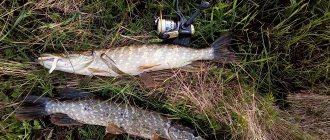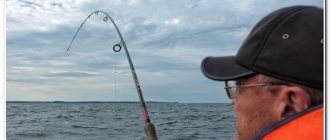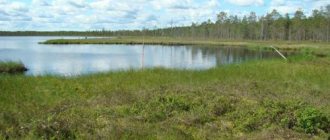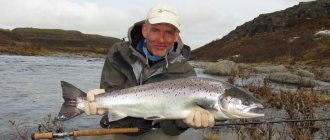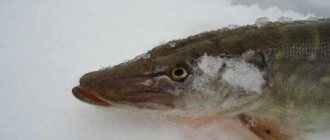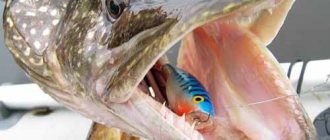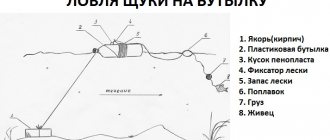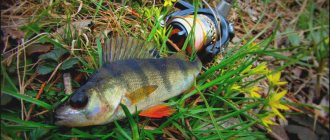Yuri 07/19/2020 656
Pike fishing is not just an exciting activity, but also an entire art. Successful fishing involves knowing the habits of fish, constantly moving in search of a good place, changing baits, correct hooking and many other nuances. Let's start with the simplest thing. Let's figure out what kind of fish this pike is.
Pike is a predator that can easily be caught at the Sazanya Bay Fishing Base. She can eat fish, worms, other toothy animals and even animals, for example, ducklings. The predator is usually not very picky when choosing food, so it is caught using silicone, spinners, spinners, wobblers and other artificial baits.
- It's worth remembering! You need to hunt for pike in different ways at different times of the year.
Fishing in the lower reaches of the Volga is a tradition
Every year I go with my friends to the Volga Delta. Here we meet comrades and brothers in our favorite weapons. The first day is a barbecue, a fire and, of course, everyone’s favorite stories, but the most important thing is fish soup. Fish soup from carp and pike perch, that’s what every fisherman dreams of.
Upon arrival, no one takes spinning rods at first, as everyone is tired from the long journey, but the next day the real fishing begins!
The sun is still so low that the body chills to the bones, and the low temperature makes you instantly wake up. Silence, only a small splash of some kind of fish can be seen in the distance.
We launch the boat into the water. The glass has to be cleaned of a decent layer of frost. In autumn, every morning is the same, and today was no exception. Finally the whole team is in full force, we can go fishing!
Fishing Travel Club. Fishing on the Lower Volga. Spring (Video)
Fishing in Astrakhan in May - June
At the end of May - beginning of June in Astrakhan, the time of the spring flood ends and the water recedes from the flood spills, taking with it into the rivers billions of fry and adults that spawned in the “hollows”. The fish is in a hurry, instinct suggests the danger of staying in dry riverbeds and small holes, where the hot sun will kill all living things, drying up the life-giving water. The fish strives for deep water, rivers, and here, at the confluence, schools of predators await it. Catfish, pike, perch, pike perch, asp know very well that the water in the river is much colder than in the sun-warmed waters of the floods, and all emerging fish, especially juveniles, will receive a short-term temperature shock, which will lead to lethargy and partial immobility of the victim, which makes her easy prey for predators.
At this time and in similar places, an experienced fisherman will dilute this “buffet” with a jig, wobbler or custom, and believe me, the results of fishing in Astrakhan in May will exceed all expectations... When fishing in May - June, the fish are active and hungry. The past spawning requires replenishment of energy reserves, and the abundance of food and comfortable water temperature cause insatiability. Catfish prefer ambushes and after an attack they go to the pits. pike stand along the riverbed, a meter or two apart from each other, outside the current. They seem to “pass the gauntlet” of the victims and make their choice with a sharp throw. Perches are friendly and organized guys: having gathered in a flock and distributing areas of responsibility, they herd the fry into a heap and sharply attack towards the shore or reeds. Asps also gather in flocks, but they attack over large areas, using their natural swiftness. The pike perch is more melancholic, but its throws are well-calibrated and it stands on the edge, waiting for the jig of a successful angler. Don’t forget about other types of fish and the variety of baits when fishing in Astrakhan in May. Spawned carp, bream, rudd, roach, tench, silver carp, crucian carp greedily grab any traditional bait, pushing fat into the body weakened by spawning. A bite similar to what you get when fishing in May - June is unlikely to be seen at any other time of the year, because all types of fish are active. The fishing bite in Astrakhan during this period lasts all day and most of the night. Previously on the topic of Fishing in May:
| Fishing in May: What fish to catch in May. Fisherman's table Fishing in May is a pleasant experience. It is already quite warm and the fish are actively looking for food, greedily grabbing the offered bait. The period of spawning ban somewhat limits fishing prowess. However, outside the spawning grounds you can safely engage... |
| Fisherman's calendar - MAY: Fishing calendar in May, lunar calendar for May The fisherman's calendar for May will tell you how and what the fish bite in May. The angler's lunar calendar for May 2021 will help you choose a good day for fishing so that you are sure to bite. And the fish-biting calendar for May will tell you which fish is best... |
Floodplain of the lower Volga and Akhtuba
Finally, the Volga is getting rid of large hydroelectric power stations and artificial dams, and the lower reaches are opening up before our eyes. The large, eye-suffocating space fascinates, and your hands are drawn to the spinning rod with the faithful and long-proven bait. But most of all I want to get to the junction of the Volga and Akhtuba.
Akhtuba is fed by the Mother of all rivers and in the spring with high water a lot of fish go to Akhtuba, which is why during this period all the fishermen of the Volgograd region rush here, since Akhtuba is located nearby and you can get here by car without problems.
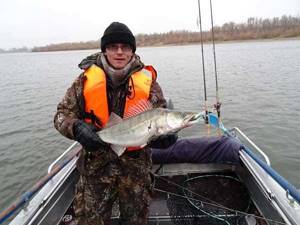
Frankly, I always come here for pike perch, fortunately there are incredible numbers of fanged ones here. Sometimes there are stories between fishermen like the one I heard. Supposedly there is a real pike perch fair in Akhtuba.
I may have agreed that this is so, but as soon as the beautiful spring leaves, it is replaced by a sultry summer and the fanged one disappears somewhere, without even leaving a note and an address at which to look for him.
The thing is that in the spring pike perch spawn and when anglers come across a spawning fanged fish, it attacks all possible baits, not for the sake of feeding, but in order to drive the bait away from the spawning area.
The bait is often a deep wobbler or edible silicone. Moreover, I noticed that on the wobbler sometimes there are such frisky bites and small holes left by the fanged on a piece of plastic - these are flowers compared to what happened to me.
I’m fishing with a wobbler, there are no bites, it’s like it’s cut off, I move to another point, make a cast, and a powerful blow almost rips the stick out of my hands. Suddenly I felt a slack at the other end of the cord and now I am the happy owner of half a wobbler for 800 rubles.
But without thinking twice, I set the same one, but a little larger in size, and perform an identical cast. The same bite and my heart almost jumped out of my chest when, after a long time of fishing, I picked up a ten-kilogram pike perch. I caught this handsome guy in the Akhtuba floodplain. I think the next trip will be even better.
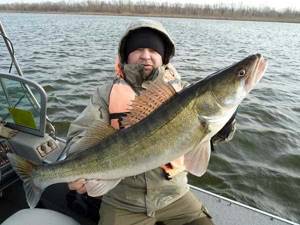
Jig fishing on Akhtuba. Mastery Lessons (Video)
Fishing in summer
In summer, suffocating heat descends on the banks of the Lower Volga and fishermen go fishing either in the early morning, when the air temperature has not yet reached 40°C, or in the afternoon, when the sun is already beginning to set towards the horizon.
The best period for catching a “predator” begins in June. There are so many fish that in the morning and evening dawn the water “boils” from its abundance. All types and methods of fishing are available and perch, catfish, asp, saberfish, bersh and other species are actively caught on the bait. Bottom tackle will allow you to catch crucian carp, bream, all kinds of whitefish and carp. Morning fishing will give you the opportunity to successfully catch carp if you stock up on bait in a timely manner. Successful fishing for catfish takes place in the early morning.

Asp are held in breaker streams, perch can be caught in all areas of the Lower Volga, and pike can be caught in recent spawning areas. All types of bait can catch a sheresper who has lost caution. It is in June that the Caspian herring “moves”, which a fisherman can catch freely only with a license.
In July, the hottest month of these places, a big problem arises with the safety of the catch; the only way to preserve the fish is immediate smoking or salting. Since buffalo, crucian carp and roach are caught well this month, this smoked fish is very good.
In August, the midday heat subsides, and the maximum number of tourists who prefer to relax in the “savage” come to the river. Fishing in August is good on the rifts.
Weather conditions on the lower Volga
Always coming to the lower Volga, I am always surprised how different everything is here from the upper reaches of our mother rivers. The climate here is so pleasant and, if you can call it so, gentle that you forget where you are. Since the Volga Delta is close to Astrakhan, the climate here is appropriate.
3 ways to improve your fish bite!
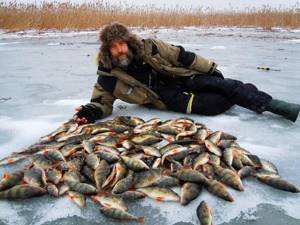
Over 15 years of active fishing, I have found many ways to improve the bite, and here are the most effective:
1. Bite activator . This pheromone additive attracts fish most strongly in cold and warm water. The Fish Hungry bite activator has proven itself to be excellent - Read more…
2. Tackle with increased sensitivity . You should first familiarize yourself with the features of using a particular type.
3. Pheromone baits . They attract the attention of fish, stimulate hunger and cause a schooling reflex, which allows you to collect a lot of fish in one place.
You can get the rest of the secrets of successful fishing for free by reading my other materials on the site.
3 ways to improve your fish bite!
Over 15 years of active fishing, I have found many ways to improve the bite, and here are the most effective:
1. Bite activator . This pheromone additive attracts fish most strongly in cold and warm water. The Fish Hungry bite activator has proven itself to be excellent - Read more…
2. Tackle with increased sensitivity . You should first familiarize yourself with the features of using a particular type.
3. Pheromone baits . They attract the attention of fish, stimulate hunger and cause a schooling reflex, which allows you to collect a lot of fish in one place.
You can get the rest of the secrets of successful fishing for free by reading my other materials on the site.
Then drive five kilometers and we are already on the Krasnodar estuaries overgrown with grass and with an angry biting pike. The weather in the lower reaches is always wonderful, only as autumn gets closer to heavy rains, it becomes more and more humid, but the fisherman does not feel any discomfort, but this affects the pike quite adequately, in general, like all the fish of the Delta.
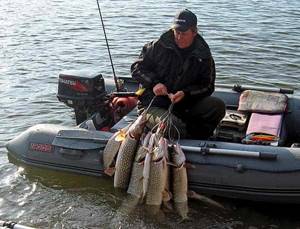
I will now tell you how climate affects fish:
— Firstly, closer to autumn, the delta becomes wetter, the atmospheric pressure becomes low and the pike is simply happy with this natural location.
For some reason this only happens in the fall, I don’t know, and I’ve never asked myself such a question, south-eastern winds begin to blow, but by the end of the season these winds are replaced by a north-western wind and the pike becomes finicky;
— As for spring , the weather is beautiful on the lower reaches of the Volga, so how can the fish not bite? but sometimes something incomprehensible happens, and the fish stops biting, even on all the most proven baits.
It all depends on how crowded the reservoir is, because every year more and more fishermen come here, the fish become wary and therefore do not take everything.
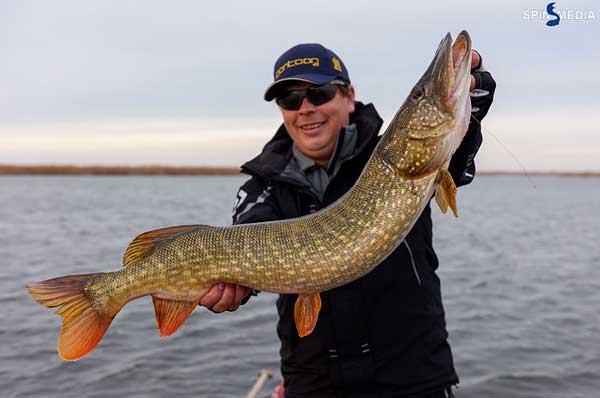
Three years ago, an exciting story about pike was filmed on the lower Volga. They chose an overgrown water area as a testing ground, fortunately there was enough of it here, and they began to fish.
It happened in the fall, and they were supposedly catching with wolves, but in reality it was not so, or rather they were catching with surface baits, but these were not wolves, but ordinary carrots from the garden.
An American colleague stood and was perplexed. Alexey Shanin, a famous fisherman, took a medium-sized carrot, made a hole in the center and inserted a hook with a string leash.
The pike bit on the first retrieve. The American would have been left with his mouth open if he had not been allowed to try to catch a pike using this method with his own hands.
In general, we did some research and came to the conclusion that the lower reaches of the Volga are the most favorable climatic zone for catching any predatory fish, but you can’t always count on Eldorado fish!
Features of fishing on the Volga
Spring
Spring fishing is active around the clock. At dusk, large pike perch take the bait, and trolling works effectively. With a spinning rod on a jig, in deep holes, you can also take a fanged fish of decent size. The baits are light green and white twisters, with jig heads weighing from 25 to 50 grams.
Pike and perch are preparing to spawn and should be looked for in bays and grassy flats. There is a chance of catching a medium-sized catfish. To do this, the bottom tackle is equipped with live bait on a diverting leash. You can catch rudd and the ubiquitous white bream using a float and bottom fishing rod. Roach and roach are no less active.
Peaceful fish prefer bait of animal origin, ideally an earthworm. Catfish indicate activity closer to mid-spring - they have not yet completely recovered from winter torpor. Strategically, it would be appropriate to move the bait smoothly in close proximity. In spring they stay in deep holes.
The silicone fish must be at least 16 cm in size, and the jig head must weigh from 45 to 85 grams. You can also use a deep-sea wobbler for trolling; exits from wintering pits should be fished.
As the water temperature increases, the asp becomes active. Its usual fight can be heard near coastal vegetation and flooded trees. The bait can be spoons, spinners and the usual castmaster.
The middle of the season is the period for catching white fish. If you check, carp are caught in eriks; in summer they are often found at relatively shallow depths. A float rod with a sliding rig would be appropriate. Bream and crucian carp are rubbing in the reed thickets. The coastal thickets are full of carp.
Pike perch comes to spawning grounds and protects nests with eggs from attacks by other predators of the reservoir. Nests are mainly located in areas of the day with difficult terrain, so the bait should be equipped with an offset hook. For white fish, a feeder rod with an asymmetrical loop is a good choice.
Summer
In summer, fishing on the Volga amazes the imagination with the activity of the bite and the diversity of the catch. At dawn, the water is teeming with a large number of representatives of ichthyofauna. With the beginning of summer, the fish leave the holes, gradually moving to the riverbed areas, and begin to actively feed. There she is in wait for the main Volga predators: catfish and pike perch.
The juveniles that arrive here are shocked by the change in temperature of the water column, and become easy prey for them. In June, the predator accumulates at the places where streams meet the main channel and where they flow out. Vytek is the place where a stream connects the hollow and the river bed.
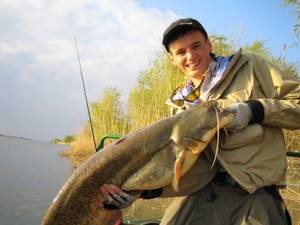
Most often, one catfish can hunt near the outlet. Once he gets enough, the next one takes his place within 30 minutes. It is very likely, in such a place, to catch a catfish weighing up to 30 kg, as a result of which the tackle must be appropriate. Pike perch bite during the day extremely reluctantly; its activity mainly extends to the night time. You can try to catch it with a spinning tackle from the shore or with a donkey with live bait as bait.
The asp is actively feeding near the shore. In summer, this predator becomes very careful; in order to catch it, you need to cast 40 meters. Pike stay in shallow bays, in grass and flooded trees, preferring places with weak currents.
The Volga carp tolerates heat well. He is a frequent visitor to coastal pits and often takes bait on the reaches. It is also active at night, when the angler is not tired of the intense heat. The bait is pearl barley shell, cake or boilies. Other peaceful fish stay in channels with a gentle current. Trophy bream and rudd can be caught from the shore without much difficulty.
Autumn
Volga autumn fishing has a clear focus on catching a variety of predatory fish. River aggressors prefer areas with strong currents, where the water mass is most saturated with oxygen.
Catfish still actively accept trolling baits on the river riffles, but by mid-autumn they smoothly move towards underwater holes. Previously successful quok fishing is no longer so effective. In sections with fast currents, the characteristic asp boilers become more and more noticeable. These are areas of accumulation of fry, which are actively dispersed by this aggressor. Accurately throwing a castmaster into such a cauldron can provide an immediate attack from a predator.
Perch readily responds to wobblers, but does not forget traditional spinners. Pike prefers trolling in deep sections of channels. The highest activity of pike perch occurs in mid-October. The fanged one can most often be seen on the edge; it actively reacts to silicone baits and does not disdain deep-sea wobblers.
The carp concentrates in deep holes with a silted bottom. Often this beauty can be found in coastal waters with flooded snags. The diet of carp gradually shifts from plant foods to the animal component. The bait can be toothless or boilies on a bottom rig.
The fish feeds all day long, gorging itself on the eve of winter. The rest of the whitefish is caught using a traditional worm from the shore. A bottom fishing rod will allow you to catch large bream, and the by-catch will always include silver bream and roach.
Winter
If we talk about winter pike perch, it is worth noting that it lives in great depths. These are dumps 16-22 meters deep. You can catch it with a jig bait using a uniform or stepped retrieve. Trolling becomes ineffective; it is necessary to fish a large area of water before getting the desired bite.
It will be more likely to catch a mustachioed catfish using a deep-sea wobbler . It is advisable to have an echo sounder in your arsenal, which will show the places of maximum concentration of fish. The main method of winter fishing on the Volga is the vertical lure method. Both vertical and horizontal baits work. The weight of such a balancer can range from 26 to 75 grams. This type of bait is preferred by pike, perch, and fanged fish.
Bersh catches are especially impressive. It is enough to discover the place of its potential parking. It may change from year to year. You can also use perch spoons using additives in the form of a worm or fish pieces. Often the by-catch contains representatives of peaceful inhabitants of the reservoir; this can be silver bream or saberfish.
In areas with fast currents, girders equipped with a large sinker perform very well. They should be installed approximately at the border with shallow water. Live bait is attached to the outlet leash, the presence of which can cause problems.
It's easier to catch fish with live bait than to get it. It is advisable to catch such bait in advance in the nearest lake, or purchase it in a special store. Live bait can be small roach and perch weighing up to 120 grams.
White fish are actively caught using heavy jigs and devils in creeks and shallow bays. The tackle can be a nodding winter rod, where the bait is a worm, bloodworm or maggot.
Species composition of fish in the Lower Volga
When asked what kind of fish lives in the Lower Volga, I will answer without thinking twice: Yes, almost everything, from small bleak to catfish, the owner of deep rivers. But by and large, only spinning anglers go to the lower reaches of the mother rivers, since they don’t see the point in other fish here.
For example, here you can catch roach on literally every cast and its size will amaze you, but asp and pike and pike perch are the number one trophies, and if you find a deep hole or spit, get ready to meet a mustachioed catfish.
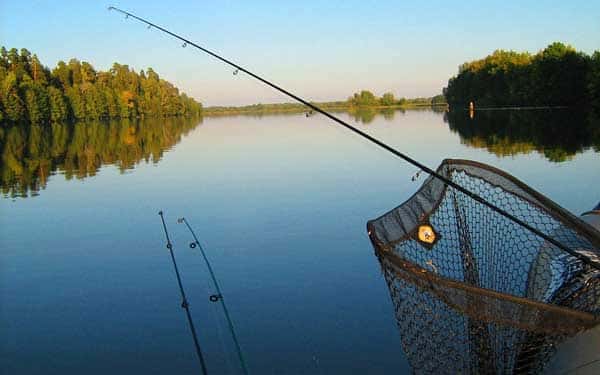
The pike perch always takes a wait-and-see attitude and walks under the blue. Everyone knows bluegill fish; if you attack such a school, then you should uncover your spinning rod. And the fanged one’s bite won’t keep you waiting long.
And here, not far away, you see how the fry practically jumps onto the shore and insatiable mouths devour everything that gets into their mouths, you shouldn’t be surprised at the fry, the robber is chasing a perch. We set up the turntable and go into battle.
Moving away from this point, we see that some kind of fish is hitting the surface, so hard that it begins to ripple in our eyes. We take a longer stick and make the longest and most accurate cast.
Then a quick retrieve and now we have a beautiful asp on the hook. And what kind of resistance it has, every bite is an adrenaline rush.
This is the kind of fishing I strive for in the lower reaches of the Volga. If you are a pike lover, then you should visit the overgrown estuaries. You can’t do without a silicone frog, or you’ll have to take a walker. If you love chub, look for a powerful stream and expect to meet a big one.
